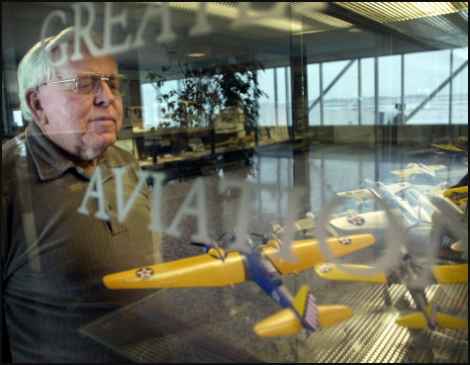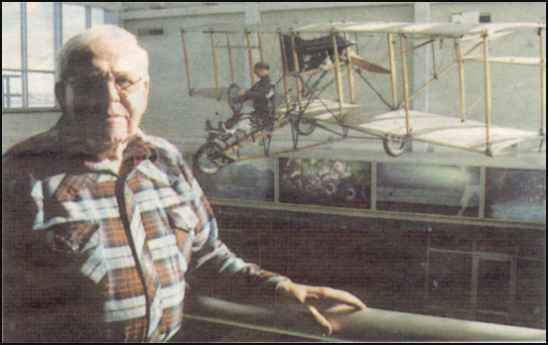
1924- |
 |
| Samuel Hoffman/The Journal Gazette |
|
Roger Myers, curator of the aviation museum at Fort Wayne International Airport, is seen behind a display case of memorabilia |
|
by Andy Gammill The Journal Gazette, 2-10-03 Roger Myers intersperses stories about fire-bombing bats and top secret engines into his tales of aviation history. As curator of the aviation museum at Fort Wayne International Airport, Myers has had fewer people come around to hear those stories than before. His collection ended up behind new security checkpoints added after the terrorist attacks of Sept. 11, 2001 Only passengers with tickets to board planes could see the exhibit. But the museum - and Myers' stories - are too good to waste, airport spokesman Sandra Lux said. Myers will start giving tours on many Tuesdays nights to anyone who goes through the effort to sign up. The 78-year-old was an Army Air Coprs bombardier in World War II and then worked at the airport for more than 30 years, retiring in 1990 as Delta's station manager. Those who take the new tours will have an even better experience than those who wander through whiile waiting for their flights because they'll get to hear Myers' stories, Lux said. "Roger is like a walking encyclopedia, and he's very interesting," Lux said. "He has all kinds of stories to relate from what he knows about World War II and his personal experiences to the terminal and the flights." There's no better ambassador from the world of flight, said Margaret Ringenberg, a pilot since the 1940s and a local aviation legend herself. "He has been with it a long time and he's been at the ariport for a long time," Ringenberg said. "Roger's the best one to do it." Myers' dedication to the museum is important to the community because it's important to remember the past, Ringenberg said. "History is always good," she said. "Not only for the children in school and the adults, but for we who like going back and looking through it and reminiscing." Reminiscing's one thing Myers is good at. His affair with the air started when as an 18-year-old in Coldwater, Ohio, he enlisted in the U.S. Army Ari Forces, which sent him to train as a bombardier in New Mexico. Although he was ready to go off to war, the Army decided he should stay in New Mexico to train other classes of future aviators. Myers didn't know it at the time, burt an experiment was going on at his base that involved bats and very small incendiary bombs. It has become one of his favorite stories to tell. The Air Corps was capturing bats from the nearby Carlsbad Caverns and fitting them with bombs with the idea of dropping them onto Tokyo, where the bats would fly into buildings and and set them on fire, Myers said. The mission never took place, but it's a great example of aviation history, Myers said. After the war, Myers returned to the Fort Wayne area. He responded to a Chicago Southern airline advertisement in The Journal Gazette seeking workers for Baer Field, which eventually became Fort Wayne International Airport. "It was heralded as one of the most modern airports in the country," he said, "and it was." Of the people who applied, Myers was hired because of his Air corps background and started out helping passenger onto planes and fueling the aircraft. Eventually he moved on to other billets in Chicago Southern, which merged with Delta. He didn't return to Fort Wayne until 1961, when he took over as the Delta station manager. He did that until 1990, when he retired. "I thoroughly enjoyed it," Meyers said. "Over the years I just had eight days' sick time off." He vividly remembers the conversation in the early 1980s that started the aviation museum. Airport manager Jim Ross was fretting over an empty display case that had been rented by International Harvester for advertising. With Harvester leaving Fort Wayne, the advertising revenue was lost and the display case was empty. "I could put some stuff in there," Myers told him, thinking of the aviation memorabilia he had stored at home. "All you'll put in there is Delta stuff," Ross said. "I have some United stuff and some Art Smith stuff, too," Myers retorted. The deal was done, and soon people started to call Myers about items they wanted to donate to the muesum. Twenty years later, he's still adding to the collection. Myers pledges that all the donations he receives are kept within the collection, the only exception being if they are lent to another museum. "We don't throw things away, we don't sell and we don't trade," he said. Among the 1,100 items in the collection are model airplanes, photographs, brochures, antique engines and propeller blades. They occupy several rows of display cases in the airport's terminal. The tours will start with a presentation about what goes on behind the scenes at the airport, Lux said, and then proceed on to a tour of the museum with Myers. The museum is an asset for the airport and for Fort Wayne, she said. "We're real pleased to have it here," Lux said. "That's why we want it open again so the community can see it." |
 |
| Curator of the Air Museum at Fort Wayne International Airport, Roger Myers, will be conducting tours of the museum for the general public twice a month. The facility on the second floor of the airport had been closed to the public since the 911 terrorist attacks of September 2001 |
|
by Rod King Until now, the only persons who could wander through the museum area on the second floor of the airport have been ticketed passengers. Lux says it is being reopened to the general public (Adults and families) in response to requests from individuals throughout the area. "The museum is really interesting for aviation and history buffs alike," says Lux. In addition, she says the reopening coincides with the year-long Centennial of Flight observance of the Wright brothers success on the beach at Kitty Hawk, North Carolina, December 17, 1903 The first tours are scheduled for March 18 and 25 from 7 to 8:30 p.m. Individuals interested in participating are urged to call the airport office at 747-4146 extension 270 to book a spot for oneself or any number of people for the evening tour. Those going on the tour will get a quick orientation about the airport, go through the security process and then join Myers for the museum visit. Other tour dates April 15 and 29, and May 13 and 27. Tours for school children and scouting groups, which have been going on since last year, are no longer limited to 25. Larger groups are welcome. In addition, Lux says that special adult only tours are now available for business groups, service clubs, church groups and other organizations of 35 to 40 people. "There VIP tours will take participants throughout the airport facility by bus. It does not include the museum." To make reservations, call 747-4146 extension 233. All of the tours are free, and so is parking. Visitors will need to bring their parking tickets in to be stamped. The museum, which has some 11,000 items on display focuses on the history of the airport, the significant individuals involved, pieces of equipment and memorabilia from when it was a military installation during World War II. Curator Myers will liven things up with stories and anecdotes of some of the local flying heroes and their escapades in the early years of aviation. One such story is the little known fact that the first woman in the world to fly an airplane, Blanche Stuart, made a rather short and unscheduled flight right here in Fort Wayne at Driving Park in the northeast side of town in 1910. Barnstorming pilot Art Smith, who died delivering the mail in 1928, is the person who put Fort Wayne on the aviation map. The monument to him in Memorial Park, is the tallest dedicated to one person in the state. He'll tell about Fort Wayne pilot Walker "Bud" Mahurin who was shot down over France in World War II and made it back to England, was shot down in the Pacific and captured by the Japanese, and shot down a third time and imprisoned in Korea, as well. Also local women pilots, Margaret Ringenberg and Marty Wyall, who served in WWII in the Womens Air Service Pilots (WASPS),. Both are on the board of the museum. Myers is a walking encyclopedia as far as the airport is concerned. He was employed by Chicgao and Southern Airlines here in 1949. The Airline later merged with Delta and he was the Fort Wayne station manager from 1961 until his retirement in 1990. He was involved in the establishment of the Air Museum, was its first president and headed the museum eight years, serves on its board and has been curator since 1991. |


|